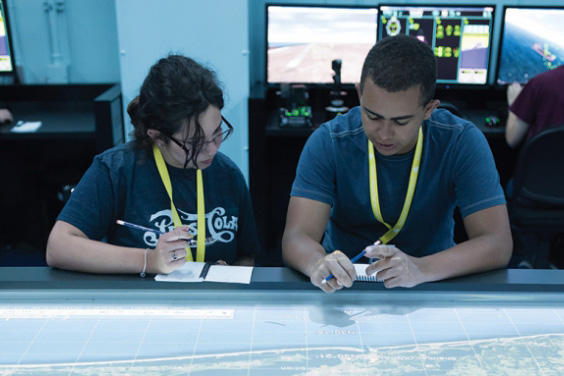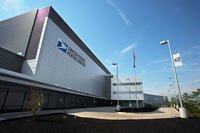Ashton McKinney concedes that he was afraid of flying before his initial session at the National Flight Academy (NFA) in Pensacola, Florida.
"The first time I came here, I was barely interested in aviation," says the Biloxi, Mississippi, resident, who has completed three weeklong sessions at the academy. "I was a little bit afraid of heights. By the end of that first week, I just knew that flying was something I wanted to do for the rest of my life."
The flight academy, which launched in 2012, has helped McKinney and thousands of other seventh- through 12th-graders from 44 states and several foreign countries develop a zest for aviation.
"Our goal is to bring a young man or woman through this program and not only get them excited about how to use mathematics and science engineering principles in a day-to-day active life, but, at the same time, give them the skills to communicate with other team members, other than ways of texting or using social media," says Chip Yarborough, NFA program director. "We are trying to get them out of that environment and get them into the environment of talking to one another verbally. Being able to make decisions. Being able to work together as a team, etc.
"It's not only what we would consider the [science, technology, engineering and mathematics] world, but also those 21st-century soft skills that we find so important in the work environment."
Students, called ambition experimental pilots (AXPs), are fully immersed in the six-day program at Naval Air Station Pensacola. Participants live "on ship" -- a multi-story, 102,000-square-foot facility -- eating in a mess hall, sleeping in staterooms and experiencing the constant rumble of the ship's engine and aircraft taking off and landing. All the senses are affected; even salt-water air is pumped in.
AXPs are also tagged with unique call names -- Waffle, Soufflé, Bling, Ace and Buzz Lightyear. They are grouped into squadrons, where they use advanced flight simulators and virtual reality technology on adrenaline-filled missions.
You won't find these simulators at an amusement park. They are state of the art, with realistic controls and motion-based movements. If an AXP team crashes, the simulator will jostle the crew around. "It really does make you feel as though it's the most realistic feeling you can get, other than being in the cockpit," McKinney says.
Combine that realism with a team-building environment and engaged instructors, and it's easy to see how students develop and embrace STEM skills.
The lessons groom the AXPs into leaders and potentially future pilots, co-pilots and air-traffic controllers. But it takes time.
Save the World Before Bedtime
On the first full day of a session last spring, students sniped at each other during the missions.
"Soufflé, what are you doing?"
"Why is your plane in the water?"
"Sir, do you know what OI is doing?"
It's not uncommon for a squadron to struggle early on. Madison and McKenna Etherton, 16-year-old twins from Biloxi, said their squadron needed to perform additional team-building exercises to help alleviate communication issues.
"We learned that we need to communicate with each other and not sass each other over the mics, because that was one reason why we were getting mad at each other and not cooperating," McKenna says.
As communication improved, so did results. Their first time in the simulator, the twins noted, their plane was in the water so often, it may have well been a jet ski. "We are the type of people who get upset when we can't do things perfectly the first try, so we were very upset in the beginning of the week," Madison recalls. "But as we got closer to the end, it's very relieving to be a lot better at it than what I ever thought we could do."
As the week progressed, all the AXPs became more confident and polished in their duties. Some emerged as leaders, helping fellow students learn. The tension from the first full day gave way to mostly controlled revelry the day before graduation.
In fact, AXPs had broken into Queen's "We Will Rock You" at the close of a lunch break during their final mission. Suddenly, the mess hall grew silent as Yarborough delivered an urgent announcement: The final mission had changed.
The AXPs quieted as Yarborough explained the situation and played a "mayday" call over the loudspeakers. A ship with unknown cargo has struck a cruise ship with more than 2,000 passengers aboard in the Gulf of Mexico. Yarborough's command to the AXPs: "We will rescue all 2,317 souls on board. That is your mission."
Students leaped into action. Determining the coordinates of the ship. Routing rescue helicopters to the scene. Racing against the clock to bring all passengers to safety. This swell of activity served as the culmination of the week's worth of lessons, drills and feedback.
"As the staff and as the ship's crew, we take a step back, and it's up to the students to lead us through this exercise and make sure that to a degree we can save the world before bedtime," Yarborough says. "They do it very well. You see them begin to take that leadership role. You see them begin to step up, and if they see something they don't like, they say, 'Hey we are making a mistake here. We need to take a look at other options.' It's a huge growth point for them, and that's wonderful to see."
Veterans Give Back
Throughout the week, instructors -- some former military pilots, others professional educators -- patiently encourage the students. Yarborough credits the veterans, who often instruct the AXPs on the technical aspects. "They all want to be involved and just give back to the students," he says. "It's just an opportunity to express, 'We realize you are the future.'"
The learning is fun for the students, but at the same time, respect is demanded and shown. The classroom, after all, is at a naval facility.
"We want to educate people on the importance of our history and how it will affect us in the future," says Legionnaire Michele Sweigart, executive director for development at the Naval Aviation Museum Foundation, which oversees the NFA. "The American Legion, Auxiliary and Sons of The American Legion take a lot of time and effort mentoring children and educating them on the importance of government and military leadership, teamwork; and that is exactly what we do here."
Sweigart belongs to Post 340 in Pensacola, which sponsored five scholarships the first year. "The kids came back and were so impressed that the next year, in 2013, we sponsored another five. The impact it had on those children was so incredible," she says.
During the 2014 fall meetings, the National Executive Committee approved a resolution endorsing the flight academy. Now organizers are promoting the program to Legion posts throughout Florida and beyond.
In the spring, Post 240 donated a $2,500 check that will fund scholarships for two students to attend an upcoming program at NFA. "This program gets the veterans into what we all used to do, whether it's on the ship or flying," Post Commander John Edens says. "It's great to get the children involved in what they used to do. I was extremely impressed the first time I visited the academy. It's five times more extensive than what I thought it was."
Sweigart sees the potential and is aiming to get other Legion departments and posts involved, perhaps sponsoring students involved with Junior ROTC, Boys State, Girls State or other youth programs.
As the program expands, Yarborough sees its technology growing, too.
"We feel like we have a very intense program right now that the kids love being involved with, but we have to introduce more technology to the program," he says. "Obviously bringing on new and more advanced technology is important to us -- upgrading our aircraft, adding more air frames that are capable of being flown from the ship. The kids love to see some of the new capabilities that are out there, so working on that next-generation aircraft we are going to be flying is important for us."
For Sweigart, "success would be a fully engaged program with a full capacity and a line wrapped around the building of kids waiting to come in."
Until then, success will be evident by the up to 144 students in each group who leave the academy with deeper STEM knowledge, close friends and perhaps a new career aspiration.
McKinney, who is entering his senior year of high school, credits the NFA staff and volunteers for the learning environment. For example, he says, AXPs must translate lessons on fuel calculations or plot out a course correctly. Otherwise, the mission will suffer.
"Before this, I wasn't particularly into science, math or engineering, but this program completely changed me," says McKinney, who is involved in Junior ROTC. "It's not like a classroom environment where you are just sitting down and the teacher lectures and you take some notes. It's full 100% applied. The way they introduce it to you is just fun; it's exciting to learn and it's very relevant."
McKinney has come a long way since he feared flying and heights. "After high school, I hope to become a Navy pilot and, hopefully after that, sign up with NASA," he says.
Registration is open for sessions at the National Flight Academy. The fee for one six-day session is $1,250. Learn more at www.nationalflightacademy.com
Henry Howard is deputy director of media and communications for The American Legion.
Want to Know More About the Military?
Be sure to get the latest news about the U.S. military, as well as critical info about how to join and all the benefits of service. Subscribe to Military.com and receive customized updates delivered straight to your inbox.











